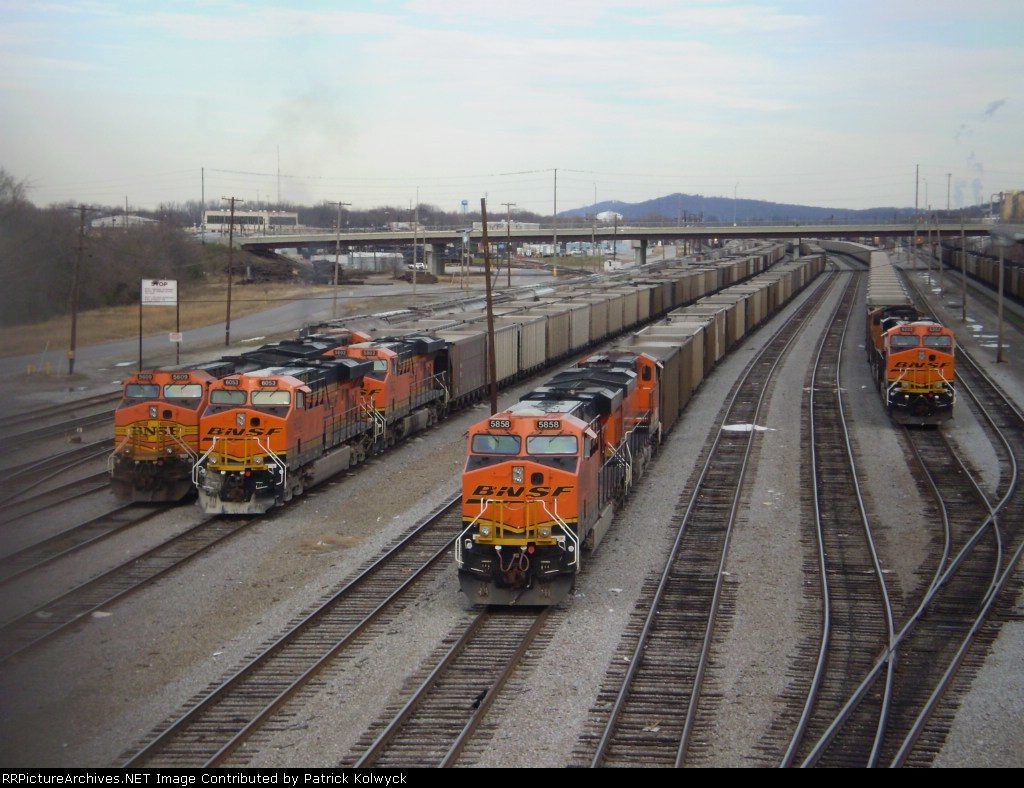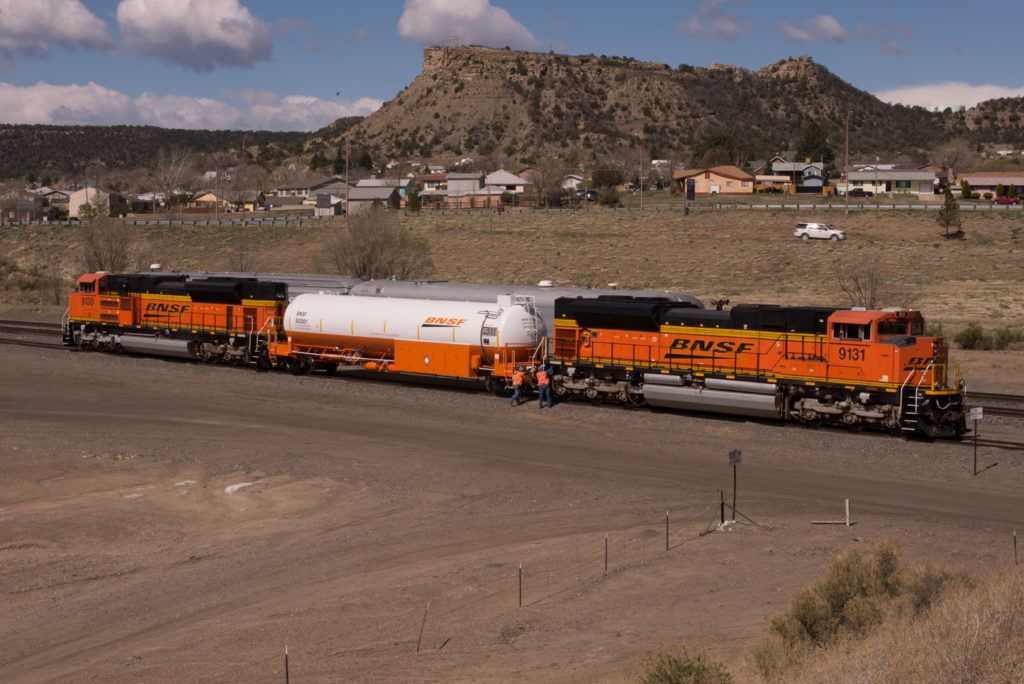BNSF: Fighting Climate Change When Your Business Burns Carbon to Move Carbon

BNSF is one of the world's largest railroads but faces challenges to its business as climate change becomes an increasingly urgent concern. Can it reform its operating model to effectively deal with these challenges?
The Burlington Northern Santa Fe Railway Company, commonly known as BNSF, is the world’s second largest railroad company as measured by revenue[i], with over 32,500 miles of track[ii]. Its predecessor railroads date to well before the time of the Civil War[iii]. However, the long history and massive scale of this logistical behemoth do not insulate it from the effects of climate change. Indeed, BNSF is already undergoing major operational changes in an attempt to cope with them.
BNSF is the largest transporter of coal[iv] and oil[v] on the continent. The viability of this business is at stake if the costs of carbon rise significantly via taxes or other pricing schemes[vi], as the long-term solvency of oil transport depends in large part on continuing high demand for hard-to-recover and heavily polluting oil sands[vii]. Meanwhile, the costs of implementing EPA’s Clean Power Plan[viii] will fall disproportionately on the rail industry and its coal transport business in particular[ix] – a segment dominated by BNSF.
BNSF coal trains. Image credit: RR Picture Archives, Patrick Kolwyck. Retrieved from <http://s3.amazonaws.com/rrpa_photos/24274/PC220231.JPG>
BNSF’s major transit hubs in the industrial Midwest have experienced unprecedented delays in recent years due to extreme weather events[x] which are likely attributable at least in part to climate change[xi]. Furthermore, the locomotives at the heart of BNSF’s service are required by EPA regulations passed in 2008 to be slowly replaced by newer units meeting EPA “Tier 4” requirements[xii].
BNSF is not blind to these challenges and is taking major steps to try to mitigate the effects of climate change on its business. They have replaced close to half of their locomotive fleet over the past decade, which has significantly lowered emissions and improved efficiency[xiii]. They have also been evaluating even more advanced locomotives that burn liquefied natural gas (LNG)[xiv]. Additionally, BNSF is creating an energy management program for its facilities and investing in renewable energy to power its properties[xv].
BNSF test locomotive fueled by LNG. Image credit: Trains Magazine. “BNSF Moves LNG Testing North”. January 9, 2015. Retrieved from <http://trn.trains.com/~/media/images/railroad-news/news-wire/2015/01/lngtrinidad_chipsherman.jpg>.
BNSF has, in my opinion, made a good start toward mitigating the risks to its operating model, but it still has a long way to go. Most problematic is the enormous fraction of revenue that the company derives from shipping coal and oil, a business which stands to potentially suffer dramatically from increased environmental regulations[xvi]. I would recommend the company attempt to slowly shift its operating mix to other commodities such as grain or intermodal[xvii], through a combination of medium term incentive pricing on those commodities and perhaps preferential scheduling to non-coal or oil carrying trains. I think BNSF should also make a large investment in data analytics software for optimal route planning to better cope with heavy delays to the rail network in future harsh winters like that of 2014.
BNSF train during the heavy winter of 2014. Image credit: Friends of BNSF. “BNSF advises customers of its stepped-up winter preparedness measures”. 30 October 2014. Retrieved from <https://www.friendsofbnsf.com/node?page=8>
BNSF could also experiment with an extra surcharge on coal or oil trains to help pay for research into genset[xviii] or LNG technology; it could also use such a carbon charge to offset its own emissions or to pay for capital improvements to the rail network to help mitigate extreme winter conditions.
An advanced low-emission BNSF genset engine. Video credit: DFWTrains “BNSF gensets 1281 and 1230 Power a Short Local Thru Sagniaw”. July 22, 2016. Retrieved from <https://www.youtube.com/watch?v=mCwsZEN3q9E>
BNSF faces great challenges to its operating model due to its form of heavily emitting motive power and its carbon-fuel heavy freight mix. However, with sound investments and planning, they can position their business to continue to be a major bedrock of transportation services for many years to come.
(799 words)
Header image credit: Mike Danneman. Retrieved from <https://s-media-cache-ak0.pinimg.com/originals/61/ea/8e/61ea8e99920974f10690d82722883919.jpg
[i] Wright, Robert. “The Biggest North American Railroads”. Financial Times. August 22, 2011. <https://www.ft.com/content/ba1227d4-ccd8-11e0-88fe-00144feabdc0> Retrieved 1 November 2016.
[ii] BNSF Railway Fact Sheet. “BNSF Railway”. BNSF. October 2016. <http://www.bnsf.com/about-bnsf/pdf/fact_sheet.pdf> Retrieved 1 November 2016.
[iii] BNSF Railway Fact Sheet. “BNSF Railway”. BNSF. October 2016. <http://www.bnsf.com/about-bnsf/pdf/fact_sheet.pdf> Retrieved 1 November 2016.
[iv] Hansen, Peter. “Coal: A Twisted Future”. Trains. March 2016. p.40-47.
[v] Frailey, Fred, and Bob Miller. “All Oiled Up”. Trains. March 2014. p.26-37.
[vi] Henderson, Rebecca, Reinert, Sophus, Dekhtyar, Polina, and Amtram Migdal. “Climate Change in 2016: Implications for Business”. Harvard Business School. HBS Case N2-317-032. October 14, 2016.
[vii] Frailey, Fred, and Bob Miller. “All Oiled Up”. Trains. March 2014. p.26-37.
[viii] “Fact Sheet: Overview of the Clean Power Plan”. Environmental Protection Agency. <https://www.epa.gov/cleanpowerplan/fact-sheet-overview-clean-power-plan> Retrieved 1 November 2016.
[ix] Hansen, Peter. “Coal: A Twisted Future”. Trains. March 2016. p.40-47.
[x] Frailey, Fred. “BNSF’s Winter to Remember.” Trains. August 2014. p.22-27.
[xi] Rossetti, Michael. “Potential Impacts of Climate Change on Railroads.” Department of Transportation. <https://climate.dot.gov/documents/workshop1002/rossetti.pdf> Retrieved 1 November 2016.
[xii] Golson, Jordan. “The Tech That Makes GE’s New Locomotive Its Cleanest Ever”. Wired. May 12, 2015. <https://www.wired.com/2015/05/tech-makes-ges-new-locomotive-cleanest-ever/> Retrieved 1 November 2016.
[xiii] “BNSF Corporate Responsibility and Sustainability Report 2014”. BNSF. 2015. <http://www.bnsf.com/communities/pdf/corporate-responsibility-report.pdf> Retrieved 1 November 2016.
[xiv] Vantuono, William. “Locomotives: Is LNG the Next Generation?” Railway Age. September 10, 2014. <http://www.railwayage.com/index.php/mechanical/locomotives/locomotives-is-lng-the-next-generation.html> Retrieved 1 November 2016.
[xv] “BNSF Corporate Responsibility and Sustainability Report 2014”. BNSF. 2015. <http://www.bnsf.com/communities/pdf/corporate-responsibility-report.pdf> Retrieved 1 November 2016.
[xvi] Hansen, Peter. “Coal: A Twisted Future”. Trains. March 2016. p.40-47.
[xvii] Frailey, Fred. “Who Does It Best?” Trains. November 2011. p.62-71.
[xviii] “’GenSet’ Locomotives”. Genesee and Wyoming. <https://www.gwrr.com/community/environment/genset_locomotives> Retrieved 1 November 2016.






This is an interesting post, CaptainKoloth, for it hints at an underlying issue of climate change: you have to be able to make the economics work.
BNSF expanded its role in crude by rail to the Bakken and other shale/oil deposits in the northwest largely due to the economic value they could realize. The Keystone Pipeline was stuck in federal regulatory debate, but oil producers had crude to move to refineries on the gulf coast. With transportation demand significantly greater than supply, there was a large opportunity for BNSF to profit from transporting crude oil. You suggest that BNSF shift its transported goods away from oil and towards other commodities, but there is significantly more competition in the commodities transportation space, thus putting pressure on BNSF’s bottom line. It is nice to think that BNSF would shift away from crude oil transport, but the economics of it make this strategy unlikely.
A more realistic solution, perhaps, is that BNSF double down on its efforts to transport the crude in an environmentally friendly way, as you suggest. BNSF’s investment in fuel-efficient or LNG locomotives is a start. Additionally, just by increasing its volume shipped, BNSF could positively impact the environment as shipping by rail is 4x more fuel efficient than shipping by truck [1]. A B2B PR campaign and salesforce messaging, paired with capacity increases, would allow BNSF to positively contribute to minimizing shipping’s impact on the climate.
[1] Rocky Mountain Institute, “Fuel Savings Potential Trucks vs Rail Intermodal,” http://www.rmi.org/RFGraph-Fuel_savings_potential_trucks_rail_intermodal
Since 2014, commodity prices have plummeted, which has left many industries — such as rail — feeling overextended. Rail leaned heavily on the energy industry to build up high volumes and comfortable margins. However, when commodities pricing plunged in 2014, rail volumes and profits plummeted.
As Elise points out above, rail is significantly more fuel efficient than trucking. The railroads have closed the gap between cross-country shipping times, such that rail takes as little as 7 days versus 6 days for trucking. However, shipping by rail is still plagued with delays, especially at the origin or destination rail yards. Thus one way for rail to be more “green” is to help customers achieve better, more efficient supply chain solutions. Thus by increasing their competitiveness with trucking, rail can swap trailers for railcars, and will help reduce the domestic supply chain industry’s carbon footprint.